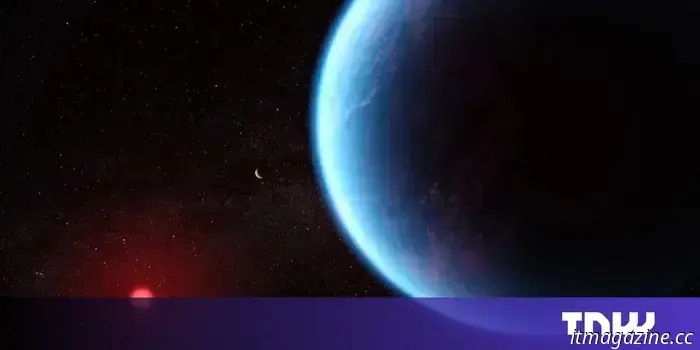
How researchers discovered the 'most compelling proof' of extraterrestrial life to date.
Astronomers utilizing the James Webb Space Telescope have reported detecting the “strongest evidence yet” of life beyond our solar system.
Researchers from the University of Cambridge identified the presence of dimethyl sulfide (DMS) and/or dimethyl disulfide (DMDS) in the atmosphere of exoplanet K2-18b. On Earth, these gases are exclusively produced by living organisms, such as phytoplankton, suggesting that K2-18b could also harbor life.
K2-18b, situated 124 light years away, is nearly three times larger than Earth and resides in a region of space where temperatures might permit liquid water. This has made the exoplanet a prime candidate in the quest for extraterrestrial life.
Equipped with the most advanced space telescope available, scientists are closer than ever to unraveling the secrets of this distant world.
How did the researchers detect signs of alien life?
To reach their conclusions, the scientists used a method called transit spectroscopy.
When K2-18b passes in front of its host star, some of the starlight filters through its atmosphere before arriving on Earth. Various gases absorb particular colors or wavelengths of starlight, which are detectable by James Webb’s instruments.
By analyzing the “missing” colors of light, the scientists were able to deduce which gases exist in the exoplanet’s atmosphere.
The latest findings bolster existing theories that K2-18b is a “hycean planet,” characterized by extensive oceans and a hydrogen-rich atmosphere.
“Based on everything we know about this planet, a Hycean world with a flourishing ocean is the scenario that aligns best with our data,” stated Professor Nikku Madhusudhan from Cambridge’s Institute of Astronomy, who spearheaded the research.
Madhusudhan and his team acknowledge that an unknown chemical process could be generating these gases. Nonetheless, the observations have reached a “three-sigma” level of statistical significance, indicating only a 0.3% chance these results occurred randomly. While this doesn’t meet the 0.00006% threshold for a recognized scientific discovery, it still constitutes compelling evidence.
In 2023, the same group of Cambridge researchers detected methane and CO2 in the atmosphere of K2-18b using two different James Webb instruments: the Near-Infrared Imager and Slitless Spectrograph (NIRISS) and the Near-Infrared Spectrograph (NIRSpec). This was the first observation of carbon-based molecules on an exoplanet within the habitable zone.
During these initial observations, the researchers also noticed faint signals that might suggest the presence of DMS. Interested by this potential finding, the team carried out follow-up observations two years later using the Mid-Infrared Instrument (MIRI).
“This provides an independent line of evidence, utilizing a different instrument from our previous work and a distinct wavelength range of light, with no overlap with earlier observations,” Madhusudhan explained. “The signal was strong and clear.”
The researchers estimate that 16 to 24 additional hours of observation time with JWST could elevate the findings to the level of a scientific discovery.
Other articles
 Tim Allen has shared the initial plot details concerning Toy Story 5, mentioning that it focuses significantly on Jessie.
So far, Allen is the only cast member to provide any clues about the potential focus of the fifth installment.
Tim Allen has shared the initial plot details concerning Toy Story 5, mentioning that it focuses significantly on Jessie.
So far, Allen is the only cast member to provide any clues about the potential focus of the fifth installment.
 The luxury watch brand Movado offers a smartwatch that is currently priced more than $350 below its retail price.
The Movado Bold Motion Smart Watch has a retail price of $795, but Jomashop is offering it for only $442. This represents a savings of $353, which is approximately a 44% discount.
The luxury watch brand Movado offers a smartwatch that is currently priced more than $350 below its retail price.
The Movado Bold Motion Smart Watch has a retail price of $795, but Jomashop is offering it for only $442. This represents a savings of $353, which is approximately a 44% discount.
 The ending of Sinners explained.
Ryan Coogler's monumental horror film, Sinners, offers a distinctive and multi-dimensional perspective on vampire horror, culminating in an impactful and moving conclusion.
The ending of Sinners explained.
Ryan Coogler's monumental horror film, Sinners, offers a distinctive and multi-dimensional perspective on vampire horror, culminating in an impactful and moving conclusion.
 The top A24 films highlight the reasons the indie company has built a fanbase in recent years, with standout titles like Lady Bird and Moonlight.
The top A24 films highlight the reasons the indie company has built a fanbase in recent years, with standout titles like Lady Bird and Moonlight.
 It’s starting to seem as though gaming may not be for everyone.
The cost of the Nintendo Switch 2 raises concerns about who might be excluded as gaming equipment becomes more expensive.
It’s starting to seem as though gaming may not be for everyone.
The cost of the Nintendo Switch 2 raises concerns about who might be excluded as gaming equipment becomes more expensive.
How researchers discovered the 'most compelling proof' of extraterrestrial life to date.
Astronomers utilizing the James Webb Space Telescope have discovered the "most convincing evidence" to date of life outside our solar system.
